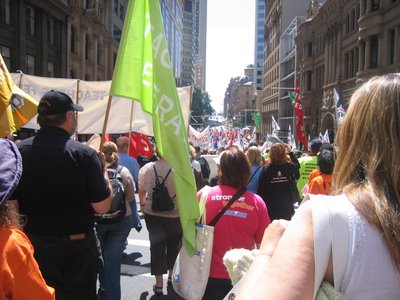








Almost the first words Kevin Little said to me when I wandered into his workshop to ask him if I could take a photo of him at work were “I’ve been here for a long time, but not for much longer”.
Kevin is 75, and, one of, if not the most pre-eminent Australian stained glass artists. His workshop is right near where I live.In its heydey, Kevin's business employed 30 artisans here and throughout country areas. But, he told me, "There’s not much of a living to be made any more from being a stained glass artist. “The Protestant churches don’t put in stained glass windows any more, and the almighty dollar rules everything. Even restoration jobs are done on the cheap these days” he said. Kevin also lamented the destruction of much of the stained glass in churches and houses as newcomers rip them out. [I'm pleased to say that we had Kevin repair one in our house when it was damaged a few years back.]
As well as work in glass, Kevin also restores furniture and all manner of things including a gorgeous grandfather clock he found in pieces in a kerbside junkout. He collects an array of things too vast to describe, and his studio/workshop is a veritable museum. Every object has a story, and the connections they weave between people are amazing.Kevin took me on a tour of his world, and I especially loved seeing a couple of fragments of 14th century stained glass, and the “sweatshop” end of the studio, where Kevin showed me the traditional method of drawing a design in chalk, before tracing it on to paper.This is true artisanship, which is not going to be there for much longer.
Kevin has had commissions from many of the leading institutions in Sydney, including Sydney Hospital, the Town Hall and St Mary’s Cathedral.
From A Village Called Arncliffe by R.W. Rathbone. (Wild and Woolley, 1997)
"David McColl Little migrated to Australia from Scotland in the 1870s. Although a butcher by trade, he became interested in the art of leadlighting and eventually obtained a position with Lyon and Cottiers the leading leadlight manufacturers and stained glass artists of their day.In1906 he moved to Arncliffe and opened his own business in Barden Street where he employed his ten children in the trade. Such was the quality of his work that he was soon receiving commissions from churches, public buildings, private homes, shop fronts and the furniture trade.When building activity declined during the Depression, he concentrated simply on glazing to see him through and as leadlighting faded from favour during the thirties and forties the process almost became a lost art.In 1944, David Little died and his business was taken over by his son, William, who, anxious to ensure that the craft did not die out, apprenticed his son Kevin to the trade.Kevin studied art at the East Sydney Technical College before succeeding his father as proprietor of the enterprise in 1956. He specialized in the restoration of ecclesiastical stained glass doing work all over Australia, New Zealand and Canada.With the upsurge of interest in restoring Victorian, Federation and Art deco houses, Kevin Little is recognized as one of the most skilled exponents of the art of leadlighting and stained glass artistry in Australia. He carries out work for the Heritage Commission, the National Trust and the Department of Public Works.H not only restores and repairs existing windows but designs memorial and heraldic windows as well. He has recently been retained to restore the windows of St Mary’s Cathedral in Sydney while his windows for the new St Matthew’s Anglican Church at Albury have been nominated for inclusion in the National Estate. "

 Part of the crowd gathered at Belmore Park to watch the live satellite broadcast from the Melbourne Cricket Ground (MCG). A second Sydney rally was held at Tumbalong Park, Darling Harbour. The two rallies converged to form a single march of 40 000 through the main streets of Sydney.
Part of the crowd gathered at Belmore Park to watch the live satellite broadcast from the Melbourne Cricket Ground (MCG). A second Sydney rally was held at Tumbalong Park, Darling Harbour. The two rallies converged to form a single march of 40 000 through the main streets of Sydney. Sharan Burow, the President of the Australian Council of Trade Unions (ACTU), and a former NSW school teacher (yay!) address the MCG crowd, esptimated to be about 50 000. People watched the broadcast in 500 venues across Australia.
Sharan Burow, the President of the Australian Council of Trade Unions (ACTU), and a former NSW school teacher (yay!) address the MCG crowd, esptimated to be about 50 000. People watched the broadcast in 500 venues across Australia. Greg Combet, Secretary of the ACTU. You can see him in a previous blog, and read more about the sort of workplace issues being fought in this campaign.
Greg Combet, Secretary of the ACTU. You can see him in a previous blog, and read more about the sort of workplace issues being fought in this campaign. Kim Beazley, Leader of the Opposition Australian Labor Party, tels the crowd at the MCG, and across Australia, that if elected in 2007, his party will "rip up these unfair laws".
Kim Beazley, Leader of the Opposition Australian Labor Party, tels the crowd at the MCG, and across Australia, that if elected in 2007, his party will "rip up these unfair laws". Part of the march through the Sydney streets.
Part of the march through the Sydney streets. 














